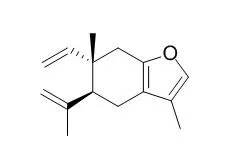| In vitro: |
| J Egypt Soc Parasitol. 2010 Dec;40(3):699-706. | | Efficacy of volatile oils (curzerene, furanoeudesma-1, 3-diene and lindestrene) on avian coccidiosis under laboratory conditions.[Pubmed: 21268538] |
METHODS AND RESULTS:
The coccidicidal efficacy of volatile oils (Curzerene, furanoeudesma-1, 3-diene and lindestrene) against unsporulated and sporulated chicken Eimeria species oocysts was tested in three concentrations: 1, 2 & 3 microg/ml. Marked reduction in the number of living oocysts was recorded in exposed groups. The concentration of 3 microg/ml volatile oils induced the highest destructive effect. 58.1% of viable unsporulated oocysts were destroyed.
CONCLUSIONS:
A mean number of 153,800 oocysts was the difference between the total number of the produced oocysts per gram faeces in the group infected with exposed oocysts and that of the group infected with non exposed oocysts being less in the exposed group with more reduction in the vitality of shedding oocysts in the former group.
At the meantime, the postmortem and histopathological microscopical examination of the intestine and caecum of the tested group revealed a reduction in the intestinal lesions in the group infected with the exposed oocysts. | | Planta Med. 2017 Jan;83(1-02):23-29. | | Cytotoxic and Antitumor Effects of Curzerene from Curcuma longa.[Pubmed: 27286338] | Curzerene is a sesquiterpene and component used in oriental medicine. It was originally isolated from the traditional Chinese herbal medicine Curcuma rhizomes.
METHODS AND RESULTS:
In this study, anticancer activity of Curzerene was examined in both in vitro and in vivo models. The result of the MTT assay showed that Curzerene exhibited antiproliferative effects in SPC-A1 human lung adenocarcinoma cells in a time-dependent and dose-dependent manner. The anticancer IC50s were 403.8, 154.8, and 47.0 μM for 24, 48, and 72 hours, respectively. The flow cytometry analysis indicated Curzerene arrested the cells in the G2/M cell cycle and promoted or induced apoptosis of SPC-A1 cells. The percentage of cells arrested in the G2/M phase increased from 9.26 % in the control group cells to 17.57 % in the cells treated with the highest dose (100 μM) of Curzerene. Western blot and RT-PCR analysis demonstrated that Curzerene induced the downregulation of GSTA1 protein and mRNA expressions in SPC-A1 cells. Tumor growth was significantly inhibited in SPC-A1 cell-bearing nude mice by using Curzerene (135 mg/kg daily), meanwhile, Curzerene did not significantly affect body mass and the organs of the mice, which may indicate that Curzerene has limited toxicity and side effects in vivo.
CONCLUSIONS:
In conclusion, Curzerene could inhibit the proliferation of SPC-A1 human lung adenocarcinoma cells line in both in vitro and in vivo models. Focusing on its relationship with GSTA1, Curzerene could induce the downregulation of GSTA1 protein and mRNA expressions in SPC-A1 cells. Curzerene might be used as an anti-lung adenocarcinoma drug candidate compound for further development. |
|






 Cell. 2018 Jan 11;172(1-2):249-261.e12. doi: 10.1016/j.cell.2017.12.019.IF=36.216(2019)
Cell. 2018 Jan 11;172(1-2):249-261.e12. doi: 10.1016/j.cell.2017.12.019.IF=36.216(2019) Cell Metab. 2020 Mar 3;31(3):534-548.e5. doi: 10.1016/j.cmet.2020.01.002.IF=22.415(2019)
Cell Metab. 2020 Mar 3;31(3):534-548.e5. doi: 10.1016/j.cmet.2020.01.002.IF=22.415(2019) Mol Cell. 2017 Nov 16;68(4):673-685.e6. doi: 10.1016/j.molcel.2017.10.022.IF=14.548(2019)
Mol Cell. 2017 Nov 16;68(4):673-685.e6. doi: 10.1016/j.molcel.2017.10.022.IF=14.548(2019)